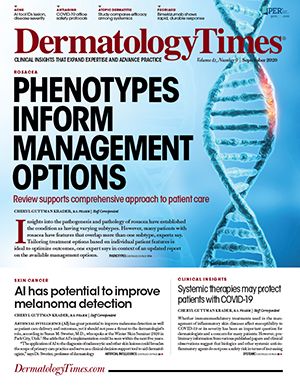- Case-Based Roundtable
- General Dermatology
- Eczema
- Chronic Hand Eczema
- Alopecia
- Aesthetics
- Vitiligo
- COVID-19
- Actinic Keratosis
- Precision Medicine and Biologics
- Rare Disease
- Wound Care
- Rosacea
- Psoriasis
- Psoriatic Arthritis
- Atopic Dermatitis
- Melasma
- NP and PA
- Skin Cancer
- Hidradenitis Suppurativa
- Drug Watch
- Pigmentary Disorders
- Acne
- Pediatric Dermatology
- Practice Management
- Prurigo Nodularis
- Buy-and-Bill
Publication
Article
Dermatology Times
COVID-19 safety guidelines provide protocols to protect staff, patients
Author(s):
Safety guidelines from the European Academy of Facial Plastic Surgery Aesthetic Medicine Focus Group describe protocols for protecting clinic staff and patients from COVID-19. Recommendations include procedures before, during and after a patient visit, as well as necessary forms.
EAFPS Aesthetic Medicine Focus Group guidance divided by section to address measures before, during and after clinic visits
Although non-surgical aesthetic facial procedures are elective and non-essential medical services, they can have a significant impact on quality of life. Yet, as patients and practices return to these procedures during the pandemic, the potential for acquiring and transmitting COVID 19 is a real one and causes concern for both parties.
Safety guidelines for non-surgical facial procedures developed by the 12 influential members of the European Academy of Facial Plastic Surgery (EAFPS) Aesthetic Medicine Focus Group address this issue. The guidelines outline protocols for protecting clinic staff and patients from SARS-CoV-2 infection. While they were developed in a short time frame, experts anticipate that the COVID-19 pandemic will persist for an extended time. The guidelines appear in a paper published in the August issue of the Journal of Cosmetic Dermatology.1
“COVID-19 is with us to stay, and whilst our esteemed researchers are working tirelessly to develop vaccines to combat this highly infective and often lethal disease, the group felt it was our utmost responsibility to set out guidelines to help our patients and practitioners,” Dario Bertossi, M.D., tells Dermatology Times. He is associate professor in maxillofacial surgery, University of Verona, Verona, Italy, and professor of practice, Centre for Integrated Medical and Translational Research, University of London, UK, is chairman of the Aesthetic Medicine Focus Group.
More on the impact of COVID-19 on practice.
“As each member of the group has immense experience in non-surgical interventions and its safety aspects, it was my obligation to crystalize this knowledge and experience for the benefit of all concerned. This is exactly what this publication sets out at present with the caveat that this guidance will evolve with time, and we are absolutely committed to update the guidance as the COVID-19 situation progresses.”
Synthesizing the guidelines
The EAFPS Aesthetic Medicine Focus Group members include highly experienced facial plastic surgeons, general plastic surgeons and dermatologists practicing across Europe, Asia, and Africa. The process of developing the safety guidelines included an initial virtual meeting in which the task force members offered their suggestions for resuming elective non-surgical facial aesthetic services safely taking into consideration experiences from individual countries. Dr. Bertossi led the discussion using a road map that he developed based on a comprehensive review of the literature, existing guidelines developed by other specialty groups, and his personal experience including personal communication with leaders within the group.
“This was possibly the most important part of the process, yet hugely rewarding,” he says.
The information from the meeting was systematically analyzed by a multidisciplinary research team using a thematic and iterative approach. Specific data were verified as needed.
Guideline content
The safety recommendations developed from the group’s input are divided into three sections that provide guidance on measures to be taken before, during, and after the clinic visit. Each of the three sections is further divided into subsections of guidelines for patients and for healthcare professionals and staff.
The written recommendations are supplemented by images and figures. These illustrative materials include a flowchart showing the route followed by patients between their arrival to and exit from the clinic. A second flowchart details protective processes to be used by providers.
In addition, the paper provides a sample form that can be distributed to and returned by patients by encrypted means prior to their visit. The form is designed to identify individuals who may have COVID-19 or been exposed to it. The form also asks for the patient’s signature documenting acknowledgment of potential risk and absolving the practice of any criminal or medicolegal liability.
A second sample form intended for distribution to patients includes general information about COVID-19, its symptoms, measures for limiting the risk of infection, and directions for when isolation or quarantine are appropriate.
The safety procedures described in the guidelines include details on types of materials to be used. For example, sodium hypochlorite 1% is recommended for pretreatment disinfection of the patient’s face, to clean eyeshields or protective glasses worn by staff, and for post-visit disinfection of devices in the procedure room. A phenolic detergent is listed as an alternative for the latter task.
For patients undergoing a nasal or intraoral procedure, 0.23% povidone-iodine solution is recommended for use as a virucide in a nasal spray or oral rinse. This added measure is important given the potential for aerosolization of respiratory droplets with these procedures.
The post-visit recommendations identify the value of minimizing follow-up visits. As an alternative to having patients return to the clinic, the guidelines suggest asking patients to submit a photograph and participate in a video consultation to communicate relevant details about their condition.
In their conclusion, the members of the EAFPS Aesthetic Medicine Focus Group note that crafting an optimal set of safety recommendations in a short period of time represents a challenge. Nevertheless, they state their belief that the product they released could offer a foundation for COVID-19 safety guidelines in aesthetic practices worldwide.
Reference:
1 Bertossi D, et al. J Cosmet Dermatol. 2020;19(8):1829-1837.






